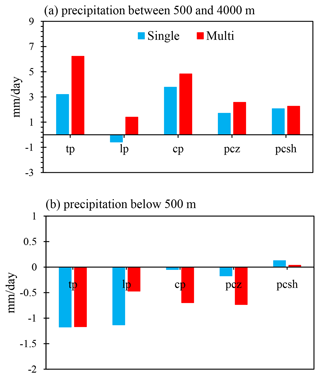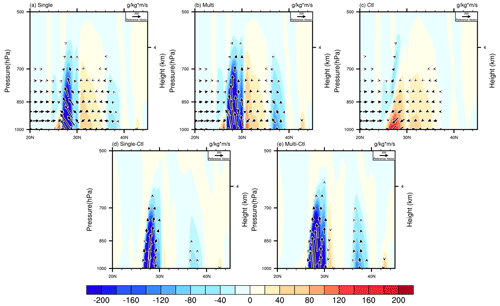the Creative Commons Attribution 4.0 License.
the Creative Commons Attribution 4.0 License.
A sub-grid parameterization scheme for topographic vertical motion in CAM5-SE
Yaqi Wang
Lanning Wang
Juan Feng
Zhenya Song
Qizhong Wu
Huaqiong Cheng
Overestimation of precipitation over steep mountains is always a common bias of atmospheric general circulation models (AGCMs). One basic reason is the imperfection of parameterization schemes. Sub-grid topography has a non-negligible role in the dynamics of the actual atmosphere, and therefore the sub-grid topographic parameterization schemes have been the focus of model development. This study proposes a sub-grid parameterization scheme for topographic vertical motion in CAM5-SE (Community Atmospheric Model version 5 with spectral element dynamical core) to revise the original vertical velocity by adding the topographic vertical motion, resulting in a significant improvement in simulations in precipitation over steep mountains. The results show a better improvement in precipitation simulation in steep mountains, such as the steep edge of the Tibetan Plateau and the Andes. The positive deviations of the precipitation on the mountain tops and the negative deviations in the windward slope are revised. The improved scheme of topographic vertical motion reduces the model biases of summer mean precipitation simulations by up to 48 % (6.23 mm d−1) on the mountain tops. The improvement in convective precipitation (4.83 mm d−1) contributes the most to the improvement in the total precipitation simulation. In addition, we extend the dynamic lifting effect of topography from the lowest layer (Single experiment) to multiple layers, approaching the bottom model layers (Multi experiment). Moreover, the water vapor transport in low-altitude regions in front of the windward slope is also considerably improved, leading to simulations of much more realistic circulation patterns in the multi-layer scheme. Since the sub-grid parameterization scheme addresses the more detailed problem caused by topography, the water vapor is transported further to the northwest in the multi-layer scheme. The topographic vertical motion schemes in both the Single and Multi experiments can improve the model performance in simulating precipitation in all regions with complex terrain.
- Article
(10518 KB) - Full-text XML
- BibTeX
- EndNote
Numerical models have been widely used and have become an essential tool to predict and simulate the weather and climate. However, there are still large deviations compared with observations, especially for precipitation simulation and prediction. It is of great scientific and social relevance to accurately simulate precipitation by using atmospheric general circulation models (AGCMs). In particular, the Coupled Model Intercomparison Project Phase 5 (CMIP5) and Phase 6 (CMIP6) models always overestimate the precipitation in regions with steep topography, which has been investigated in previous studies (Liu et al., 2014; Akinsanola et al., 2021; Cui et al., 2021). Jia et al. (2019) found that all CMIP5 models overestimate the monthly precipitation over the Tibetan Plateau by an average of 48.2 mm (∼150 %), with larger biases during spring and summer. Zhu and Yang (2020) also found that the model biases over the Tibetan Plateau in the CMIP6 models were even larger (more positive) than in the CMIP5 models. Similar problems also exist in precipitation simulations in other mountain regions with steep terrain, such as the Andes in South America, the Rocky Mountains of North America and Indonesia. Excessive precipitation was simulated in both weather and climate models and global and regional models in regions with steep and high mountains but less precipitation before the foothills of the steep slope (Done et al., 2004; Kunz and Kottmeier, 2006; Alpert et al., 2012; Chao, 2012; Navale and Singh, 2020).
The reasons for excessive precipitation simulated by numerical models over steep mountains are complex, involving the horizontal resolution, dynamical framework, physical processes and their complicated interactions (Liang et al., 2021). There is plenty of evidence of a close relationship between orography and precipitation patterns at spatial scales of a few kilometers, even in climatological precipitation rates. Thus, improving model resolution is a possible way to improve the biases of precipitation simulations. Kimoto et al. (2005) found that higher-resolution versions of general circulation models (GCMs) can better characterize the frequency distributions of different precipitation patterns. Similar results can be found in regional models. Lin et al. (2018) compared the simulations with resolutions of 30, 10 and 2 km based on the Weather Research and Forecasting model, and they found that higher-resolution simulations can reduce positive precipitation biases over the Tibetan Plateau. However, increasing spatial resolution does not always improve precipitation simulations in some areas, for example, in the lowlands of southeastern England (Chan et al., 2013; Wang et al., 2017). The relationship between the spatial resolution of models and the quality of precipitation simulation remains elusive. Additionally, high-resolution climate models require a large amount of computation and storage. Some parameterization schemes are also proposed to improve the accuracy of precipitation simulation, which mainly focus on the parameterization schemes for physical processes. For example, in the past 20 years, much effort has been made to develop stochastic convection schemes and apply them to numerical models, resulting in some substantial improvements in precipitation simulation (Chen et al., 2010; Fonseca et al., 2015; Wang and Zhang, 2016; Attada et al., 2020).
The simulation bias of topographic precipitation has been a challenge for numerical models. Most studies are based on improving model resolution and the parameterization schemes of physical processes, but few studies have focused on the modification of the dynamic framework for numerical models, especially the dynamic lifting. At spatial scales greater than approximately 40 km and for mountain ranges exceeding approximately 1.5 km in height, the maximum condensation is generated over low, steep and windward slopes due to upslope flow (Roe, 2005). An important quantity of orographic precipitation is water vapor flux. In numerical models, Yu et al. (2015) replaced the semi-Lagrangian method with a finite-difference approach for the trace transport algorithm to restrain the “overshoot” of water vapor to the high-altitude region of the windward slopes. Codron and Sadourny (2002) tested the advected water vapor with respect to saturation values and redistributed it accordingly over the grid points found along the advecting path. Actually, these two schemes add the limitation of supersaturation for water vapor advection, which may cause partial precipitation when the water vapor advects up mountain slopes along terrain-following routes. Less water vapor is transported to summits and plateaus and instead settles on windward slopes and foothills, thus improving precipitation simulations in steep mountains. These studies only improved the scheme of water vapor advection schemes. Shen et al. (2007) proposed a sub-grid correction parameterization scheme for pressure tendency by considering slope and orientation according to the disturbance lifting caused by each fine grid. Based on this, the precipitation simulation in the regional climate model of Nanjing University over complex terrain areas was improved, but it is only a case study of precipitation simulation in eastern China.
As mentioned above, sufficient water vapor and dynamic lifting are the necessary conditions for precipitation (Shen et al., 2021). Considering the shortcomings of the current dynamic lifting studies for numerical models, we propose a sub-grid parameterization scheme of topographic vertical motion and apply it in CAM5 (Community Atmospheric Model version 5), one of the global atmosphere general circulation models, to improve precipitation simulation in areas with complex terrain. In particular, we extend the dynamic lifting effect of topography on airflow from the lowest model layer to multiple layers and consider the influence of the decay of vertical airflow.
The remainder of this paper is organized as follows. Section 2 describes the modeling context and the data used in this research and details the sub-grid parameterization scheme for topographic vertical velocity. Section 3 analyzes and compares the precipitation simulated by two topographic vertical velocity experiments. The main conclusions and discussion are presented in Sect. 4.
2.1 CAM5-SE
The models used in this study are the Community Earth System Model (CESM; Hurrell et al., 2013) version 1.2.1 from the National Center for Atmospheric Research (NCAR) and the Community Atmospheric Model version 5 (CAM5; Neale et al., 2010) with the new spectral element dynamical core (CAM5-SE). CAM5-SE is based on the High-Order Method Modeling Environment (HOMME) spectral element method (Dennis et al., 2012) and adopts a conventional vector-invariant form of the moist primitive equations. Note that CAM5-SE uses the vector-invariant form of the momentum equation instead of the vorticity–divergence equation. The pressure vertical velocity can be expressed by , as shown in Eq. (1).
Given the description of the coordinate in CAM5-SE, the continuous system of equations can be written following the first law of thermodynamics (Kasahara, 1974, and Simmons and Strüfing, 1981). The prognostic equations are as shown in Eq. (2) (Neale et al., 2010).
The third equation in Eq. (2) above shows that in the SE dynamic framework, vertical velocity affects the tendency of temperature directly and affects pressure P through the equation of state P=ρRT indirectly. Thus, the correction of vertical velocity can change the atmospheric circulation and precipitation.
The major model physics of CAM5-SE include the following: (1) the separate deep convection scheme is ZM (Zhang and McFarlane, 1995; Richter and Rasch, 2008), (2) the shallow convection scheme is University of Washington (UW; Park and Bretherton, 2009), (3) the cloud microphysics scheme is MG1.0 (Morrison and Gettelman, 2008; Gettelman et al., 2010), (4) the moist turbulence scheme for calculating sub-grid vertical transport of heat and moisture is diag_TKE (turbulent kinetic energy; Bretherton and Park, 2009), and (5) the radiation scheme is the Rapid Radiative Transfer Model for GCM (RRTM-G) package (Mlawer et al., 1997).
2.2 Topographic vertical motion and sub-grid topography parameterization scheme
Alpert and Shafir (1989) found that orographic precipitation at microscale and mesoscale is highly predictable with the adiabatic assumption that the lifting is determined by V⋅∇Zs. The surface vertical velocity caused by the forced lifting of topography can be expressed by Eq. (3).
In the P-coordinate system, Eq. (3) can be rewritten as Eq. (4):
where Vs and ps indicate the surface wind velocity and the surface pressure, respectively. After considering the topographic vertical velocity, vertical velocity can be rewritten as Eq. (5):
where ωs denotes the topographic vertical velocity of the lowest model layer, θ is the wind direction, θN is the slope, φN is the aspect, ρ is air density, and g is gravitational acceleration. It can be seen that the surface topographic vertical velocity is proportional to the surface wind speed, the tangent of the slope, and the cosine of the angle between the mountain aspect and the wind direction. Figure 1a shows the distribution of surface topographic vertical velocity with the slope and the angle between the wind direction and aspect of wind speed. In fact, the angle between the mountain aspect and the wind direction ranges from 0 to 360∘. When the angle is in the range of 0–90∘ or 270–360∘, it indicates an ascending motion, while the angle of 90–270∘ represents a descending motion. The angle range of 0–90∘ is chosen just because it can cover the range of cosine values and is adequately representative. This study only focuses on the simulation of precipitation caused by blocking uplift on windward slopes. At the current model resolution, the maximum slope captured by digital elevation model (DEM) data is 61∘, indicating that the maximum surface topographic vertical velocity is about 22 Pa s−1 and is positively correlated with slope. That is, when the mountain is the steepest and the angle between the wind direction and aspect is the smallest, the topographic vertical velocity reaches the maximum. However, when the slope is less than ∼5∘, the topographic vertical velocity is so small that it can be ignored.
Generally, Shen et al. (2007) proposed a sub-grid correction parameterization scheme for pressure tendency in the reginal climate model of Nanjing University. However, the topographic vertical motion affects not only the lowest model level but also the near-surface layers. Thus, we extend the topographic vertical velocity from a single layer to multiple layers, as shown in Eq. (7):
where ωl is multi-layer topographic vertical velocity, and pl is multi-layer pressure. γ indicates the attenuation coefficient of topographic vertical velocity ωs, and it increases with the elevation, as shown in Eq. (8):
where f represents the Coriolis term, p0 is the reference pressure, p is the actual pressure, is a constant, and L is the wavelength. Because of the complexity of the hyperbolic sine function calculation and the fact that the initial pressure in complex terrain areas actually does not start from the sea level but from the surface layer, we simplify Eq. (9) according to the Taylor series to make γ become an exponential function that varies only with latitude and pressure difference Δp:
where Δp indicates the difference between the surface pressure and the pressure on a certain model layer, and dl is model horizontal resolution. is static variable which can be preprocessed at each integration step without calculation. After simplification, the divergence of γ between Eqs. (8) and (9) is only 10−10. Thus, the simplified Eq. (9) can be applied in numerical models to calculate the multi-layer topographic vertical velocity.
Figure 1b shows the linear variation in the unit topographic vertical velocity intensity with altitude at the given model resolution. The results indicated that with the increase in model resolution, the topographic vertical velocity decreases rapidly with altitude. When L=10 km, the topographical vertical velocity is negligible 10 hPa above the surface, which is lower than the next layer of the lowest model vertical layer in CAM5-SE, so a single-layer parameterization scheme is enough. For L=150 km, the influence reaches up to 150 hPa above the surface, so a multi-layer topographic vertical velocity parameterization scheme is necessary. It can provide some new information for numerical simulations. Notably, preprocessing the sub-grid topographic data before the model integration may simplify calculation.
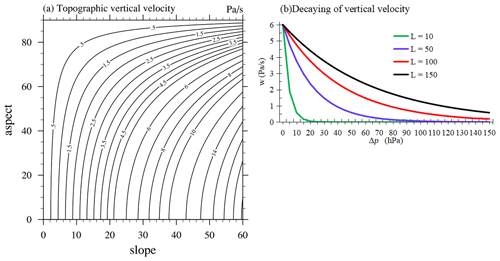
Figure 1(a) Distribution of surface topographic vertical velocity (Pa s−1) at different slopes and aspects at 10 m s−1 wind speed; (b) the decrease in the unit topographic vertical velocity with height at different grid scales.
The trigonometric function of slope and aspect calculated by Eq. (6) is parameterized to the model dynamic processes to evaluate the topographic vertical motion. The topographic data used in this study are from the United States Geological Survey (USGS) DEM with a resolution of 1 km × 1 km (sub-grid). The simulations are performed at the horizontal resolution of a different model grid (coarse grid). Thus, the coarse grid contains several sub-grids. We define a coarse grid as a terrestrial grid when the number of sub-grids on land occupies more than 10 % of the total number of sub-grids; otherwise it is a marine grid. If the number of sub-grids with slope ≥5∘ in the terrestrial grid exceeds 10 %, the terrestrial grid is considered a complex-topographic-area coarse grid and needs to be parameterized. After that, the product of the trigonometric functions of the slope and aspect of each sub-grid in the complex-topographic-area coarse grid is calculated – that is tanθN×cos φN (TC) and tanθN×sin φN (TS). According to Wang et al. (2022a), it was found that the sub-grids contained in the coarse grids of all topographic areas follow a Gaussian distribution. Then the representative value of several sub-grid topographic values at the coarse-grid scale is selected () and can be easily described and applied (Wang et al., 2022a). Finally, we bring the representative value into Eq. (6) to calculate ωs. Before the experiments, advanced preprocessing is used to calculate the probability densities of the trigonometric function and grid weights.
2.3 Experimental design and data
The CAM stand-alone model can be run using CESM scripts, which is coupled to a data ocean model, a thermodynamic sea ice model and an active land model, when one of the “F” component sets of CESM is chosen. We choose the F_2000_CAM5 component set of CESM to conduct numerical experiments. The simulations are performed at the horizontal resolution of ne30 (about 1∘) and 30 hybrid sigma pressure levels, with an integration time step of 1800 s. Three 6-year simulations are forced by the prescribed current sea surface temperature and sea ice range with seasonal variations and are recycled yearly (Stone et al., 2018). The one without any modification is the control experiment (Ctl experiment). The others are the sensitivity experiments, which are the same as the control experiment but consider the lowest topographic vertical velocity (Single experiment) and the decrease in multi-layer topographic vertical velocity (Multi experiment). All three cases are carried out for 6 years, and the first year of simulation is discarded as spin-up.
The Global Precipitation Climatology Project (GPCP) Level 3 Monthly 0.5-Degree V3.0 beta (Huffman et al., 2019) from 1987 to 2016 is used to evaluate the simulated precipitation. Monthly mean atmospheric data, comprising surface pressure, specific humidity, and zonal and meridional wind (at 11 vertical levels from 1000 to 700 hPa) during 1991–2021, are from the European Centre for Medium-Range Weather Forecasts Reanalysis 5 (ERA5) dataset on a 0.25∘ × 0.25∘ grid used for comparison with model results (Hersbach et al., 2020). The lowest model layer wind is derived from ERA-Interim at a 0.25∘ horizontal grid spacing and 60 model levels.
2.4 Improvement or divergence ratio
Divergence ratio is an indicator used to measure the difference ratio between simulation results and observation results. Improvement ratio is an indicator used to measure the improvement ratio between Single (Multi) and Ctl experiments. In mountain meteorology, the precipitation enhancement ratio (PER) is the ratio of the precipitation P at mountain peak or some other selected points to the precipitation at the reference point or in the reference region PREF, as presented in Eq. (10).
The reference region should be far enough removed that it is unaffected by the mountain but still in the same climate zone (Smith, 2019). We extend Eq. (10) to any physical quantity to obtain Eq. (11).
where ΔP indicates the difference in simulations between the sensitivity and control experiments or the difference between the simulations from the control experiment and observation data. PREF represents simulations from the control experiment. Then, the PER reflects the improvement ratio or divergence ratio.
3.1 Precipitation simulation over the Tibetan Plateau
A region of 22–45∘ N and 70–105∘ E is selected to cover the Tibetan Plateau. The Tibetan Plateau is influenced by the plateau monsoon and has a distinct seasonal pattern of wet summer and dry winter (Su et al., 2013). The precipitation reaches its annual maximum in summer, accounting for 60 %–70 % of the annual accumulated precipitation (Yanai and Wu, 2006; Wang et al., 2018). Therefore, summer precipitation is of great significance for this study in the region.
The geographical distributions of boreal summer (June–August, JJA) mean precipitation amount from GPCP, Ctl, Single and Multi experiments are shown in Fig. 2. In summer, most precipitation over East Asia is related to the Indian summer monsoon and the East Asian summer monsoon (Tao and Chen, 1987). The results indicate that for GPCP (Fig. 2a), a large rainfall amount is concentrated in the Bay of Bengal and the southeastern periphery of the Tibetan Plateau, but for the simulations from the Ctl (Fig. 2b), Single (Fig. 2c) and Multi (Fig. 2d) experiments, little rainfall is received in these areas. However, the precipitation increase appears on the southern slope of the Tibetan Plateau in model experiments, but there is little rainfall in this region in GPCP.

Figure 2Spatial distributions of summer (June–August) average precipitation amount (mm d−1) from (a) the GPCP data and simulations in the (b) Ctl, (c) Single and (d) Multi experiments. Vectors in (a) represent the summer wind at the lowest model level in ERA-Interim, vectors in (b)–(d) represent the summer wind simulation at the lowest model level, and the black contour indicates an altitude of 3000 m.
In order to illustrate the biases of the model simulation and the improvement in the topographic vertical motion scheme, the differences in the summer precipitation between sensitivity experiments, Ctl experiment and GPCP are shown in Fig. 3. The most striking feature of the bias distribution is its close relation with topography. Positive precipitation bias controlling the Tibetan Plateau has been a common error in many climate models for a long time (Yu et al., 2015). The largest overestimations of the Ctl experiment (Fig. 3c) are found over the eastern and southern edges of the Tibetan Plateau, mostly in the regions with altitudes of 500 and 4000 m. According to Eq. (11), the divergence ratio is about 80 % (Fig. 3f). In addition, the larger underestimations of precipitation can be found in front of the southern slope of the Tibetan Plateau, mostly in the region below the altitude of 500 m. The region with the largest underestimation is located in the area of 22∘ N, 90–98∘ E, with an underestimation ratio of about 100 %. However, underestimation ratios in other regions are 20 %–40 %. This result indicates that the southwesterly wind transports the water vapor from the ocean to the southern slope of the Tibetan Plateau. Due to the mountains, the airflow climbs upward and produces plenty of precipitation. The simulation bias is that the condensate that should have been generated in the Bay of Bengal is brought to the southern slope of the Tibetan Plateau. It is noteworthy that after considering the topographic vertical velocity, the simulation results are remarkably improved. The positive precipitation deviations on the southern and eastern edges of the Tibetan Plateau and the negative deviations in the low-altitude region of the windward slope are obviously improved. Moreover, the Multi experiment (Fig. 3b) performs better than the Single experiment (Fig. 3a), and the improvement ratios of positive deviations for the Single and Multi experiments are both 20 %–30 % (Fig. 3d and e). The results above indicate that the modification of topographic vertical velocity plays a vital role in topographic precipitation simulations.
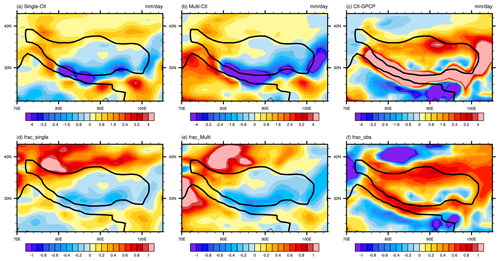
Figure 3Differences in summer average precipitation amount (mm d−1) (a) between Single and Ctl experiments, (b) between Multi and Ctl experiments, and (c) between Ctl experiment and GPCP; improvement ratio of (d) Single experiment and (e) Multi experiment; and (f) divergence ratio of Ctl experiment. Black contours indicate the altitudes of 500 and 4000 m.
More details of model performance and precipitation variations are revealed by the meridional and latitudinal averages of precipitation over the Tibetan Plateau. The meridional average precipitation throughout the Tibetan Plateau over 87–95∘ E (Fig. 4b) suggests that the precipitation peak for the Ctl experiment (green line) is located north of GPCP (black line), but there is more precipitation than for GPCP. The precipitation distribution for the Single (blue line) experiment is the same as that for the Ctl experiment. However, the peak in the Multi experiment (red line) is located north of GPCP, but the rain intensity is nearly equal. This result indicates that considering the decaying of multi-layer vertical velocity can significantly reduce the overestimation of precipitation over the south foot of the Tibetan Plateau. Figure 4a shows the latitudinal average of precipitation over 22–25∘ N. Compared with GPCP (black line), the Ctl experiment (green line) considerably underestimates the rainfall in front of the southern edge of the Tibetan Plateau. At the eastern peak at 91∘ E, the difference between Ctl and GPCP is about −8.41 mm d−1, and the maximum value of the Multi experiment (14.51 mm d−1) presents a similar magnitude to that of GPCP (17 mm d−1). At the windward peak at 26∘ N, the difference between Ctl and GPCP is about 12.5 mm d−1, and the value of the Single experiment (14.1 mm d−1) presents a similar magnitude to that of GPCP (14.22 mm d−1).

Figure 4Summer precipitation averaged over (a) 22–25∘ N and (b) 87–95∘ E. Green, red, blue and black lines represent the simulated precipitation in the Ctl, Multi and Single experiments and from the GPCP data, respectively. The gray dotted lines indicate the altitude (Hgt, in km).
In terms of the biases of model simulations, Fig. 5 presents differences in convective precipitation, large-scale precipitation, shallow convective precipitation and ZM convective precipitation between the simulations and GPCP. The deviations in the convective precipitation present almost the same spatial pattern (Fig. 5a and e) as the total precipitation (Fig. 3a and b), especially along the southern and eastern edges of the Tibetan Plateau. The deviation in the spatial pattern of large-scale precipitation is slightly different (Fig. 5b and f). The Single and Multi experiments only revise the positive deviations of precipitation in the middle region of the southern slope (28–32∘ N, 82–88∘ E), and the simulations of the Multi experiment are slightly higher than those from the Single experiment. However, both Single and Multi experiments greatly improve the negative deviations of precipitation in front of the southern slope (22–25∘ N, 90–97∘ E). The deviations in the spatial pattern of shallow convective precipitation (Figs. 5c and 6g) are almost the same between Single and Ctl experiments and between Multi and Ctl experiments, and the most negative deviations are both located at altitudes above 500 m. In the regions with altitudes below 500 m, the deviation of the ZM convective precipitation (Fig. 5d and h) presents almost the same spatial pattern as that of the convective precipitation (Fig. 5a and e).
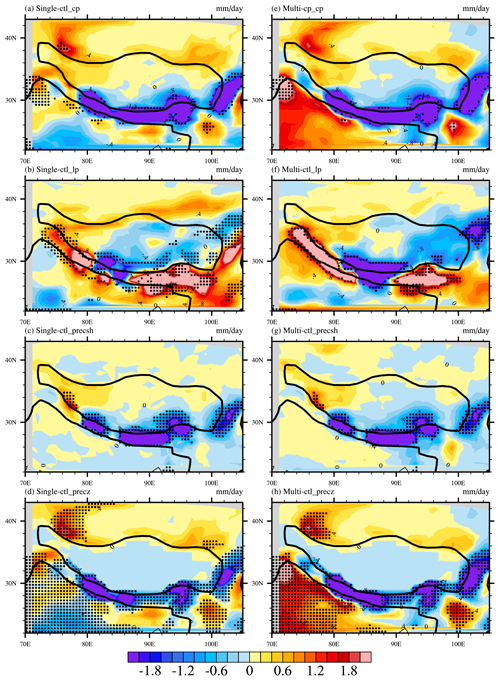
Figure 5Difference in (a) convective precipitation, (b) large-scale precipitation, (c) shallow convection precipitation and (d) precipitation from ZM convection between Single and Ctl experiments. (e–h) As in (a)–(d) but between Multi and Ctl experiments. Black contours indicate the altitudes of 500 and 4000 m. Dotted areas are statistically significant at the 90 % confidence level.
To further analyze which type of precipitation improvement is dominant, we investigate the contributions of convective precipitation, large-scale precipitation, ZM convective precipitation and shallow convective precipitation to the improvement in total precipitation simulations (Fig. 6). The results suggest that for the improvement in the overestimation of total precipitation at altitudes from 500 to 4000 m (pink shaded areas in Fig. 3c), the Multi experiment performs better than the Single experiment. The total precipitation overestimation of 12.9 mm d−1 is improved by 6.23 mm d−1 for the Multi experiment and 3.23 mm d−1 for the Single experiment (Fig. 6a). For the Multi experiment, the improvement in convective precipitation (4.83 mm d−1) accounts for the largest part, while the large-scale precipitation is only 1.4 mm d−1. This is due to the fact that the water vapor is lifted higher by the topographic vertical motion in the Multi experiment, which is favorable for triggering convective precipitation. In terms of convective precipitation, there is little difference in the improvement between the shallow convective and ZM convective precipitation, and the improvements in precipitation simulations are both about 2 mm d−1. The improvement in precipitation simulation for the Single experiment is similar to that for the Multi experiment, but the large-scale precipitation negatively contributes to the improvement in total precipitation in the Single experiment. Below 500 m, the underestimation of the total precipitation is about 3 mm d−1, and the Single and Multi experiments both improve ∼1.2 mm d−1, but the composition of precipitation types contributing to the improvement is different (Fig. 6b). In the Single experiment, the decrease in biases comes mainly from the improvement in large-scale precipitation simulation, and the improvement in convective precipitation can be negligible. This is because in the Single experiment, the water vapor of the whole layer is lifted, and therefore the improvement in the total precipitation simulation is dominated by the improvement in the large-scale precipitation simulation. However, the contribution of convective precipitation to the improvement in the total precipitation simulation is greater than that of the large-scale precipitation in the Multi experiment. Moreover, ZM convective precipitation is the dominant precipitation type in convective precipitation, and shallow convective precipitation makes a negative contribution to the improvement in the total precipitation simulation.
3.2 Circulation simulation over the Tibetan Plateau
To further investigate the impact of vertical circulation on precipitation simulations, Fig. 5 displays the vertical pressure velocity, meridional vertical circulation and their difference averaged over 87–95∘ E. It can be found that for the Single, Multi and Ctl experiments (Fig. 7a–c), there is strong southerly wind near 27–38∘ N, but the Ctl experiment does not simulate the variability in the vertical velocity. The vertical motion for the Single and Multi experiments appears at 28∘ N, which is an essential factor of orographic precipitation. Figure 7d and e visually show the differences between the vertical pressure velocity and meridional–vertical circulation among the Single, Multi and Ctl experiments. Mountain blocking has an impact on the Indian summer monsoon, reducing the southerly wind component in the Single and Multi experiments compared to the Ctl experiment. Due to the stronger vertical motion, the vertical and southerly wind components for the Multi experiment are stronger than those for the Single experiment.
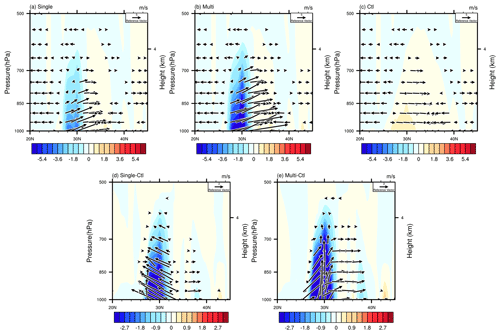
Figure 7Meridional–vertical circulation (vectors) and vertical velocity (shading) averaged over 87–95∘ E in the (a) Single, (b) Multi and (c) Ctl experiments, as well as their differences (d) between the Single and Ctl experiments and (e) between the Multi and Ctl experiments.
Since the differences in the total precipitable water (TPW) and 10 m wind are related to precipitation, we analyze the distributions of the spatial differences in the 10 m wind and TPW for the Single, Multi and Ctl experiments over the Tibetan Plateau (Fig. 8). Compared with the Ctl experiment, the TPW shows negative deviations on the southern and eastern edges of the Tibetan Plateau in both the Single and Multi experiments. In front of the southern slope, the TPW presents positive deviations in the Multi experiment (Fig. 8a) but negative deviations in the Single (Fig. 8b), indicating that the Multi experiment improves the precipitation simulation in front of the windward slope and allows the water vapor to be transported to the front of the southern slope of the Tibetan Plateau with the Asian monsoon. This result is consistent with the precipitation distribution in Fig. 3. Also, the 10 m wind can prove this result. In the Single and Multi experiments, the wind speed in high-altitude regions decreases. However, only in the Multi experiment are there positive deviations at the southern foot of the Tibetan Plateau, i.e., low-altitude windward-slope regions (Fig. 8a and b).
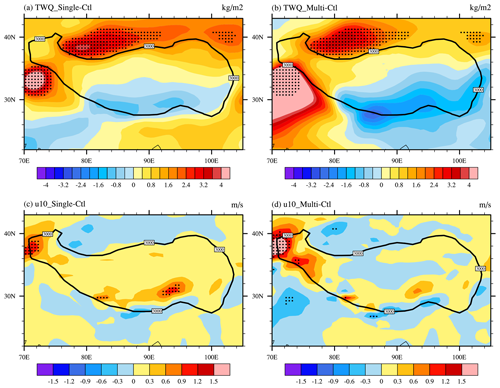
Figure 8Difference in (a, b) total precipitable water (kg m−2) and (c, d) 10 m wind speed (m s−1) between the Single, Multi and Ctl experiments. Dotted areas are statistically significant at the 90 % confidence level.
Water vapor transport is a critical factor in determining precipitation distribution, and an essential quantity for the orographic precipitation is the horizontal water vapor flux. As shown in Fig. 9, the water vapor transported from the northern Indian Ocean reaches the coast of the Asian continent along the Indian peninsula and the Bay of Bengal in the Ctl (Fig. 9c), Single (Fig. 9a) and Multi (Fig. 9b) experiments and ERA5 (Fig. 9d). After that, the water vapor is separated into two branches, one of which reaches the southern slope of the Tibetan Plateau and flows eastward after being blocked by the plateau. The other branch transports eastward. Compared with the Ctl experiment, more water vapor is transported from the northern Indian Ocean in the Multi experiment, and more water vapor converges in front of the southern slope of the Tibetan Plateau (24–26∘ N, 80–87∘ E), but less water vapor climbs the slope. Additionally, the water vapor transported eastward weakens due to the blocking of the plateau, forming a weakened “water belt”. It can be explained by Yu et al. (2015); i.e., the altitude of the land surface jumps from lower than 200 m to more than 4000 m within approximately four model grids, and CAM5 (Ctl experiment) allows the multi-grid transport and spurious accumulated water vapor at cold and high-altitude regions. In contrast, the scheme of multi-layer topographic vertical motion implemented in the Multi experiment considers the climbing and bypassing of airflow. Thus, in the Multi experiment, water vapor is more in low-altitude regions and less in high-altitude regions. As a result, the precipitation is more in front of the slope and less on the southern slope of the Tibetan Plateau, which is consistent with the previous conclusion of total precipitation (Fig. 3). When the water vapor transports northward, there is a branch of water vapor in East Asia which moves northwestward after bypassing the west and weakens markedly. This leads to a decrease in precipitation on the eastern edge of the Tibetan Plateau. Therefore, for the differences between the simulations and observations, the excessive precipitation on higher slopes and less precipitation on lower slopes are considerably improved. In terms of the Single experiment, the variation in water vapor presents almost the same spatial pattern as that in the Multi experiment but less than in the Multi experiment. The only difference is that there is no noticeable increase in water vapor on lower slopes due to less pronounced variation in precipitation. Rahimi et al. (2019) investigated the relationship between the location of the precipitation peak along slopes and horizontal resolution, and they found that finer resolution could allow the peak location to move northward. Previous studies found that the orographic drag of complex topography may only be resolved at horizontal resolutions of a few kilometers or even finer resolutions (Sandu et al., 2016; Wang et al., 2020). However, our research demonstrates that considering the sub-grid parameterization scheme of slope gradient and surface and adding the topographic vertical motion in CAM5-SE can address the impacts of topographic complexity on precipitation. It significantly improves the underestimation of precipitation over the windward slope of the Tibetan Plateau and the overestimation of precipitation over the steep edge of high mountains at the horizontal resolution of hundreds of kilometers, which is equivalent to the horizontal resolutions of a few kilometers or a few months of simulation in climate models (Li et al., 2022).
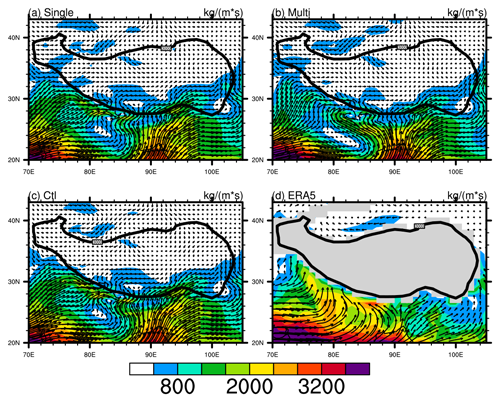
Figure 9Distribution of the composite whole-layer water vapor flux (from the lowest model level to the seventh model level) in the (a) Single, (b) Multi and (c) Ctl experiments and (d) ERA5 over East Asia. Black contours indicate the altitudes of 3000 m.
Upslope flow is critical for orographic precipitation, which allows air to climb over mountains more easily (Smith, 2019). Figure 10 presents the meridional–vertical cross section of water vapor transport along 90∘ E. The results suggest that for the Single and Multi experiments (Fig. 10a and b), the vertical water vapor transport considerably enhances from 27∘ N, and even the lifting height in the Multi experiment is higher than that in the Single experiment. Compared with the Ctl experiment, the lifting height of water vapor reaches about 700 hPa in the Single experiment (Fig. 10d), while it reaches about 650 hPa in the Multi experiment (Fig. 10e). The upslope flow supplies the water vapor to the windward slope, and the airflow blocking reduces the precipitation over the region above 500 m.
3.3 Precipitation simulation in other complex terrain areas
A similar precipitation response can be found in other high mountains, such as the Andes in South America. Figure 11 shows the biases of precipitation simulated in the Single, Multi and Ctl experiments in South America during austral summer (December to February). It can be found that in December–February, there is strong southerly wind at 850 hPa (Fig. 11a and b) on the western edge of the Andes (from west of 30 to 10∘ S), and large positive precipitation biases can be found in front of the foot of the Andes (Fig. 11c). In the Ctl experiment, the precipitation is overestimated on ridges above 1000 m and is underestimated in some low-altitude regions on the eastern slope. These biases are closely associated with the strong wind at 850 hPa on the eastern edge of the Andes. In both Single and Multi experiments (Fig. 11a and b), the overestimation of precipitation decreases on ridges above 1000 m and increases on the windward slope in the eastern region of the Andes.
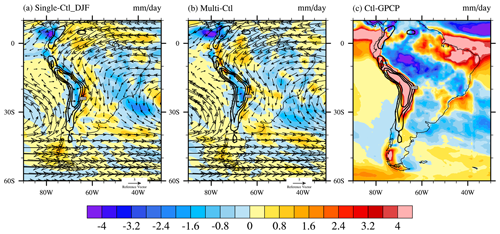
Figure 11Differences in winter (December–February) average precipitation amount (mm d−1) (a) between Single and Ctl experiments, (b) between Multi and Ctl experiments, and (c) between Ctl experiment and GPCP over South America. Vectors in panels (a) and (b) represent the 850 hPa wind in the Single and Multi experiments, respectively. Black contours indicate the altitudes of 1000 and 2000 m.
The distributions of spatial differences in the specific humidity and TPW in South America for the Single, Multi and Ctl experiments are shown in Fig. 12. Similar to on the Tibetan Plateau, compared with the Ctl experiment, the TPW shows negative deviations on mountain tops in both the Single and Multi experiments, which is in agreement with the precipitation distribution in Fig. 11. However, the TPW on the foot of the northeastern slope (windward) only displays positive deviations in the Multi experiment but negative deviations in the Single experiment (Fig. 12a and b). This result suggests that the Multi experiment improves the precipitation simulation in front of the windward slope, and in both the Multi and Single experiments, the water vapor is transported to the eastern slope. Thus, the TPW accumulates in this area to form large positive deviations. The results for the specific humidity (Fig. 12c and d) and TPW are consistent. In the Single and Multi experiments, there are dry deviations in high-altitude regions. However, only in the Multi experiment are there wet deviations at the southern foot of the Tibetan Plateau, i.e., the low-altitude windward-slope regions.
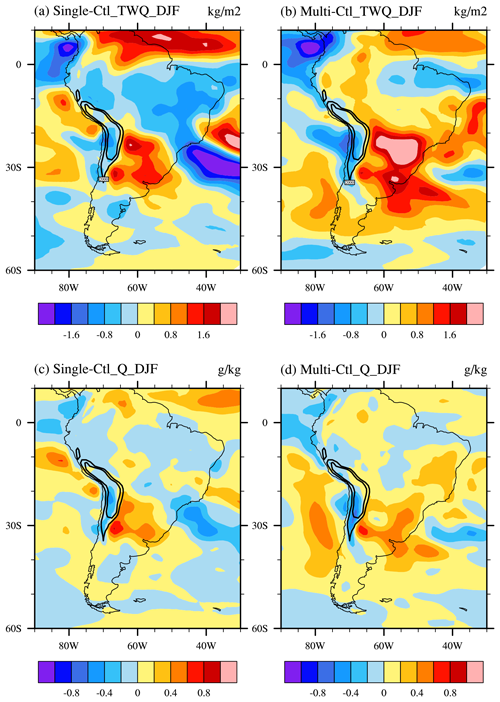
Figure 12Difference in (a, b) total precipitable water (kg m−2) and (c, d) the lowest-model-level specific humidity (g kg−1) between Single, Multi and Ctl experiments over South America. Black contours indicate the altitudes of 1000 and 2000 m.
Table 1 presents the root mean square error (RMSE) of precipitation simulations in several typical areas with complex terrain during boreal summer or winter (figure omitted). The results indicate that on the Tibetan Plateau (22–45∘ N, 70–105∘ E; boreal summer precipitation), in Equatorial New Guinea and Indonesia (10∘ S–10∘ N, 100–150∘ E; boreal summer precipitation), in South America (60∘ S–5∘ N, 30–90∘ W; boreal winter precipitation), and in North America (30–65∘ N, 155–122∘ W; boreal winter precipitation), the RMSE values of precipitation simulations in the sensitivity experiments are smaller than those in the Ctl experiment. For the Ctl experiment, the RMSE is the largest over the Tibetan Plateau (5.44) and the smallest over North America (1.57). Almost all GCMs have large deviations in precipitation simulations on the Tibetan Plateau. Therefore, after considering the dynamic lifting of topography, the improvement in biases in this area is the most pronounced, followed by Equatorial New Guinea (26.3 %), and the smallest is in North America (9.55 %). Moreover, the improvement in the Multi experiment is better than that in the Single experiment, reaching about 29.23 %, which indicates that the steeper the mountains are, the more obvious the influence of lifting condensation on multi-layer vertical velocity is. The impact of single topographic vertical motion is limited to low-altitude areas. However, in Africa, the surface is relatively flat, and the slope gradient is small (Wang et al., 2022a). Thus, the method in this research may not be as effective, so it is no longer mentioned in Table 1.
Notably, the improvement in precipitation simulations is noticeable over the Tibetan Plateau but not in the Rocky Mountain region in North America (figure omitted). The main reason is that in the Rocky Mountain region, the wind direction is parallel to the mountain range, and the angle between the prevailing wind direction on the western side of the mountain (steep slope) and the slope surface is close to 90∘. Thus, there can be no lifting motion caused by topography. The topographic vertical motion is not only dependent on the slope gradient, but is also associated with the angle between the wind direction and the slope surface. Therefore, the large amount of water vapor from the ocean cannot be transported to the mountains. In order to understand and solve these remaining problems, more numerical experiments and more detailed analyses should be further conducted. Moreover, when we only consider the steep slope of mountains, it would greatly impact the precipitation simulation of the regional climate. Future research is also needed to investigate the possibility of applying the topographic vertical motion scheme to extreme precipitation simulations in local areas, allowing weather models to more accurately simulate extreme precipitation caused by topography.
A common bias of the AGCMs is the overestimation of orographic precipitation. One primary reason for this bias is the imperfection of the sub-grid terrain parameterization scheme. One critical reason is that the influence of topographic lifting on airflow and water vapor transport is not considered in numerical models. In this study, we investigate whether such excessive precipitation simulation can be improved by considering the topographic vertical velocity in CAM5-SE. The results show that the simulated precipitation in steep regions is sensitive to topographic vertical velocity. In the Multi experiment, the underestimated total precipitation is remarkably improved at lower layers on steep windward slopes. However, in the Ctl experiment, there are large dry biases, but the overestimation of precipitation in high-altitude areas of steep mountains is markedly reduced in the Multi experiment. The increase in precipitation on steep windward slopes and the decrease in precipitation in high-altitude areas of mountains are mainly due to the contribution of convective precipitation, which is greater in the Multi experiment than in the Single experiment. The improvement in precipitation simulations is closely related to dynamic lifting. If the dynamic uplifting effect is not considered, every grid is flat without considering the slope gradient and slope surface. In this case, a large amount of water vapor accumulates in high-altitude areas on the top of mountains. This is partially responsible for the excessive water vapor and precipitation in high-altitude regions of steep mountains in the Ctl experiment.
Moreover, in this study, the sub-grid parameterization scheme of the topographic vertical motion performs well in precipitation simulations over complex terrains, such as the Tibetan Plateau and the Andes in South America. Moreover, the improvement in precipitation simulations for the Multi experiment is better than that for the Single experiment. As shown in Fig. 1a, with increasing numerical model resolution, the influence of topography on multi-layer vertical velocity weakens. Therefore, it is necessary to use high-resolution numerical experiments to verify whether the dynamic lifting effect of sub-grid topography on airflow still exists.
GPCP V3.0 data are available from https://doi.org/10.5067/TTO0VJF2FSYR (last access: 29 June 2022; Huffman et al., 2022). DEM data can be found at http://usgs.gov/ (last access: 29 June 2022; Kornus et al., 2006). The ERA5 atmospheric datasets used in this study are available from https://doi.org/10.24381/cds.6860a573 (last access: 29 June 2022; Hersbach et al., 2023). The source code of CAM-SE5.3 is available from http://www.cesm.ucar.edu/models/cesm1.2/ (last access: 20 April 2022, NCAR, 2018).. The dataset related to this paper is available online via Zenodo: https://doi.org/10.5281/zenodo.7256923 (Wang et al., 2022b).
YW and LW designed the experiments and the scope and structure of the manuscript. YW carried out the simulations and analyzed the results with help from JF, ZS, QW and HC. All authors gave comments and contributed to the development of the paper.
The contact author has declared that none of the authors has any competing interests.
Publisher's note: Copernicus Publications remains neutral with regard to jurisdictional claims made in the text, published maps, institutional affiliations, or any other geographical representation in this paper. While Copernicus Publications makes every effort to include appropriate place names, the final responsibility lies with the authors.
The authors would like to thank the administrator of the High Performance Scientific Computing Center (HSCC) of Beijing Normal University for providing the high-performance computing (HPC) environment and technical support.
The research work was financially supported by Laoshan Laboratory (grant no. LSKJ202202100) and the National Natural Science Foundation of China (grant no. 42375162).
This paper was edited by Richard Neale and reviewed by two anonymous referees.
Akinsanola, A. A., Ongoma, V., and Kooperman, G. J.: Evaluation of CMIP6 models in simulating the statistics of extreme precipitation over Eastern Africa, Atmos. Res., 254, 105509, https://doi.org/10.1016/j.atmosres.2021.105509, 2021.
Alpert, P. and Shafir, H.: Mesoγ-Scale Distribution of Orographic Precipitation: Numerical Study and Comparison with Precipitation Derived from Radar Measurements, J. Appl. Meteorol., 28, 1105–1117, 1989.
Alpert, P., Jin, F., and Shafir, H.: Orographic precipitation simulated by a super-high resolution global climate model over the Middle East, National Security and Human Health Implications of Climate Change, 1, 301–306, https://doi.org/10.1007/978-94-007-2430-3_26, 2012.
Attada, R., Dasari, H. P., Kumar, R. K., Langodan, S., Kumar, K. N., Knio, O., and Hoteit, I: Evaluating cumulus parameterization schemes for the simulation of Arabian Peninsula winter rainfall, J. Hydrometeorol., 21, 1089–1114, 2020.
Bretherton, C. S. and Park, S.: A new moist turbulence parameterization in the community atmosphere model, J. Climate, 22, 3422–3448, 2009a.
Chan, S. C., Kendon, E. J., Fowler, H. J., Blenkinsop, S., Ferro, C. A. T., and Stephenson, D. B.: Does increasing the spatial resolution of a regional climate model improve the simulated daily precipitation?, Clim. Dynam., 41, 1475–1495, 2013.
Chao, W. C.: Correction of excessive precipitation over steep and high mountains in a GCM, J. Atmos. Sci., 69, 1547–1561, 2012.
Chen, H. M., Zhou, T. J., Neale, R. B., Wu, X. Q., and Zhang, G. J.: Performance of the new NCAR CAM3.5 in East Asian summer monsoon simulations: sensitivity to modifications of the convection scheme, J. Climate, 23, 3657–3675, 2010.
Codron, F. and Sadourny, R.: Saturation limiters for water vapour advection schemes: impact on orographic precipitation, Tellus A, 54, 338–349, 2002.
Cui, T., Li, C., and Tian, F.: Evaluation of temperature and precipitation simulations in CMIP6 models over the Tibetan Plateau, Earth Space Sci., 8, e2020EA001620, https://doi.org/10.1029/2020ea001620, 2021.
Dennis, J., Edwards, K., Evans, J., Guba, O., Lauritzen, P. H., Mirin, A. A., St-Cyr, A., Taylor, M. A., and Worley, P. H.: CAM-SE: A scalable spectral element dynamical core for the Community Atmosphere Model, Int. J. High Perform. C., 26, 74–89, 2012.
Done, J. M., Leung, L. R., Davis, C. A., and Kuo, B.: Regional climate simulation using the WRF model. Preprints, Fifth WRF/14th MM5 Users' Workshop, Boulder, CO, National Center for Atmospheric Research, P8, http://www.mmm.ucar.edu/mm5/workshop/ws04/PosterSession/Done.James.pdf (last access: 29 June 2022), 2004.
Fonseca, R. M., Zhang, T., and Yong, K.-T.: Improved simulation of precipitation in the tropics using a modified BMJ scheme in the WRF model, Geosci. Model Dev., 8, 2915–2928, https://doi.org/10.5194/gmd-8-2915-2015, 2015.
Gettelman, A., Liu, X., Ghan, S. J., Morrison, H., Park, S., Conley, A. J., Klein, S. A., Boyle, J., Mitchell, D. L., and Li, J.-L. F.: Global simulations of ice nucleation and ice supersaturation with an improved cloud scheme in the community atmosphere model, J. Geophys. Res., 115, D18216, https://doi.org/10.1029/2009JD013797, 2010.
Hersbach, H., Bell, B., Berrisford, P., Hirahara, S., Horányi, A.,Muñoz-Sabater, J., Nicolas, J., Peubey, C., Radu, R., Schepers, D., Simmons, A., Soci, C., Abdalla, S., Abellan, X., Balsamo, G., Bechtold, P., Biavati, G., Bidlot, J., Bonavita, M., De Chiara, G., Dahlgren, P., Dee, D., Diamantakis, M., Dragani, R., Flemming, J., Forbes, R., Fuentes, M., Geer, A., Haimberger, L., Healy, S., Hogan, R. J., Hólm, E., Janisková, M.,Keeley, S., Laloyaux, P., Lopez, P., Lupu, C., Radnoti, G., de Rosnay, P., Rozum, I., Vamborg, F., Villaume, S., and Thépaut, J.-N.: The ERA5 global reanalysis, J. Meteorol. Soc. Japan, 146, 1999–2049, https://doi.org/10.1002/qj.3803, 2020.
Hersbach, H., Bell, B., Berrisford, P., Biavati, G., Horányi, A., Muñoz Sabater, J., Nicolas, J., Peubey, C., Radu, R., Rozum, I., Schepers, D., Simmons, A., Soci, C., Dee, D., and Thépaut, J.-N.: ERA5 monthly averaged data on pressure levels from 1940 to present, Copernicus Climate Change Service (C3S) Climate Data Store (CDS) [data set], https://doi.org/10.24381/cds.6860a573 (last access: 29 June 2022), 2023.
Huffman, G. J., Bolvin, D. T., and Nelkin, E. J.: GES DISC Dataset: GPCP Precipitation Level 3 Monthly 0.5-Degree V3.0 Beta (GPCPMON 3.0), https://disc.gsfc.nasa.gov/datasets/GPCPMON_3.2/summary (last access: 29 June 2022), 2019.
Huffman, G. J., Behrangi, A., Bolvin, D. T., and Nelkin, E. J.: GPCP Version 3.2 Satellite-Gauge (SG) Combined Precipitation Data Set, edited by: Huffman, G. J., Behrangi, A., Bolvin, D. T., Nelkin, E. J., Greenbelt, Maryland, USA, Goddard Earth Sciences Data and Information Services Center (GES DISC) [data set], https://doi.org/10.5067/MEASURES/GPCP/DATA304 (last access: 29 June 2022), 2022.
Hurrell, J. W., Holland, M. M., Gent, P. R., Ghan, S., Kay, J. E., Kushner, P. J., Lamarque, J.-F., Large, W. G., Lawrence, D., Lindsay, K., Lipscomb, W. H., Long, M. C., Mahowald, N., Marsh, D. R., Neale, R. B., Rasch, P., Vavrus, S., Vertenstein, M., Bader, D., Collins, W. D., Hack, J. J., Kiehl, J., and Marshall, S.: The community earth system model: a framework for collaborative research, B. Am. Meteorol. Soc., 94, 1339–1360, 2013.
Jia, K., Ruan, Y., Yang, Y., and Zhang, C.: Assessing the Performance of CMIP5 Global Climate Models for Simulating Future Precipitation Change in the Tibetan Plateau, Water, 11, 1771, https://doi.org/10.3390/w11091771, 2019.
Kasahara, A.: Various vertical coordinate systems used for numerical weather prediction, Mon. Weather Rev., 102, 509–522, 1974.
Kimoto, M., Yasutomi, N., Yokoyama, C., and Emori, S.: Projected changes in precipitation characteristics around Japan under the global warming, SOLA, 1, 85–88, 2005.
Kornus, W., Alamus, R., Ruiz, A., and Talaya, J.: DEM generation from SPOT-5 3-fold along track stereoscopic imagery using autocalibration, ISPRS J. Photogramm. Remote, 60, 147–159, 2006.
Kunz, M. and Kottmeier, C.: Orographic enhancement of precipitation over low mountain ranges. Part II: Simulations of heavy precipitation events over Southwest Germany, J. Appl. Meteorol. Climatol., 45, 1041–1055, 2006.
Li, G., Chen, H., Xu, M., Zhao, C., Zhong, L., Li, R., Fu, Y., and Gao, Y.: Impacts of Topographic Complexity on Modeling Moisture Transport and Precipitation over the Tibetan Plateau in Summer, Adv. Atmos. Sci., 39, 1151–1166, 2022.
Liang, Y., Yang, B., Wang, M., Tang, J., Sakaguchi, K., Leung, L. R., and Xu, X.: Multiscale Simulation of Precipitation Over East Asia by Variable Resolution CAM-MPAS, J. Adv. Model. Earth Sy., 13, e2021MS002656, https://doi.org/10.1029/2021MS002656, 2021.
Lin, C., Chen, D., Yang, K., and Ou, T.: Impact of model resolution on simulating the water vapor transport through the central Himalayas: implication for models' wet bias over the Tibetan Plateau, Clim. Dynam., 51, 3195–3207, 2018.
Liu, Z., Mehran, A., Phillips, T. J., and AghaKouchak, A.: Seasonal and regional biases in CMIP5 precipitation simulations, Clim. Res., 60, 35–50, 2014.
Mlawer, E. J., Taubman, S. J., Brown, P. D., Iacono, M. J., and Clough, S. A.: Radiative transfer for inhomogeneous atmospheres: RRTM, a validated correlated-k model for the longwave, J. Geophys. Res., 102, 16663–16682, https://doi.org/10.1029/97JD00237, 1997.
Morrison, H. and Gettelman, A.: A new two-moment bulk stratiform cloud microphysics scheme in the NCAR Community Atmosphere Model (CAM3). Part I: Description and numerical tests, J. Climate, 21, 3642–3659, 2008.
Navale, A. and Singh, C.: Topographic sensitivity of WRF-simulated rainfall patterns over the North West Himalayan region, Atmos. Res., 242, 105003, https://doi.org/10.1029/2020JD033396, 2020.
NCAR: CESM Models, http://www.cesm.ucar.edu/models/cesm1.2/, NCAR [code], last access: 20 April 2022.
Neale, R. B., Chen, C., Gettelman, A., Lauritzen, P. H., Park, S., Williamson, D. L., Conley, A. J., Carcia, R., Kinnison, D., Lamarque, J., Marsh, D., Mills, M., Smith, A. K., Tilmes, S., Morrison, H., Cameron-Smith, P., Collins, W. D., Iacono, M. J., Easter, R. C., Ghan, S. J., Liu, X., Rasch, P. J., and Tayloy, M. A.: Description of the NCAR community atmosphere model (CAM 5.0), NCAR tech note TN-486, 2010.
Park, S. and Bretherton, C. S.: The University of Washington Shallow Convection and Moist Turbulence Schemes and Their Impact on Climate Simulations with the Community Atmosphere Model, J. Climate, 22, 3449–3469, 2009.
Rahimi, S. R., Wu, C. L., Liu, X. H., and Brown, H.: Exploring a variable-resolution approach for simulating regional climate over the Tibetan Plateau using VR-CESM, J. Geophys. Res., 124, 4490–4513, 2019.
Richter, J. H. and Rasch, P. J.: Effects of convective momentum transport on the atmospheric circulation in the community atmosphere model, version 3, J. Climate, 21, 1487–1499, 2008.
Roe, G. H.: Orographic precipitation, Annu. Rev. Earth Planet. Sci., 33, 645–671, 2005.
Sandu, I., Bechtold, P., Beljaars, A., Bozzo, A., Pithan, F., Shepherd, T. G., and Zadra, A.: Impacts of parameterized orographic drag on the Northern Hemisphere winter circulation, J. Adv. Model. Earth Sy., 8, 196–211, 2016.
Shen, S., Xiao, H., Yang, H., Fu, D., and Shu, W.: Variations of water vapor transport and water vapor-hydrometeor-precipitation conversions during a heavy rainfall event in the Three-River-Headwater region of the Tibetan Plateau, Atmos. Res., 264, 105874, https://doi.org/10.1016/j.atmosres.2021.105874, 2021.
Shen, Y., Zhang, Y., and Qian, Y.: A Parameterization Scheme for the Dynamic Effects of Subgrid Topography and Its Impacts on Rainfall Simulation, Plateau Meteorology, 26, 655–665, 2007 (in Chinese).
Simmons, A. J. and Strüfing, R.: An Energy and Angularmomentum Conserving Finite-difference Scheme, Hybrid Coordinates and Medium-range Weather Prediction, Technical Report 28, European Centre for Medium-Range Weather Forecasts, Reading, UK, 1981.
Smith, R. B.: 100 Years of progress on mountain meteorology research. A Century of Progress in Atmospheric and Related Sciences: Celebrating the American Meteorological Society Centennial, Meteor. Monogr., No. 59, Amer. Meteor. Soc., https://doi.org/10.1175/AMSMONOGRAPHS-D-18-0022.1, 2019.
Stone, D., Risser, M. D., Angelil, O., Wehner, M., Cholia, S., Keen, N., Krishnan, H., Obrien, T. A., and Collins, W. D.: A basis set for exploration of sensitivity to prescribed ocean conditions for estimating human contributions to extreme weather in CAM5.1–1degree, Weather Clim. Extremes, 19, 10–19, 2018.
Su, F., Duan, X., Chen, D., Hao, Z., and Cuo, L.: Evaluation of the global climate models in the CMIP5 over the Tibetan Plateau, J. Climate, 26, 3187–3208, 2013.
Tao, S. Y. and Chen, L. X.: A review of recent research on the East Asian summer monsoon in China, in: Monsoon Meteorology, edited by: Chang, C. P. and Krishnamurti, T. N., Oxford University Press, 60–92, 1987.
Wang, X., Pang, G., and Yang, M.: Precipitation over the Tibetan Plateau during recent decades: a review based on observations and simulations, Int. J. Climatol., 38, 1116–1131, 2018.
Wang, Y. and Zhang, G. J.: Global climate impacts of stochastic deep convection parameterization in the NCAR CAM5, J. Adv. Model. Earth Sy., 8, 1641–1656, 2016.
Wang, Y., Zhang, G. J., and He, Y.-J.: Simulation of precipitation extremes using a stochastic convective parameterization in the NCAR CAM5 under different resolutions, J. Geophys. Res.-Atmos., 122, 12875–12891, 2017.
Wang, Y., Yang, K., Zhou, X., Chen, D., Lu, H., Ouyang, L., Chen, Y., Lazhu, and Wang, B.: Synergy of orographic drag parameterization and high resolution greatly reduces biases of WRF-simulated precipitation in central Himalaya, Clim. Dynam., 54, 1729–1740, 2020.
Wang, Y., Wang, L., Feng, J., Song, Z., Wu, Q., and Cheng, H.: A statistical description method of global sub-grid topography for numerical models, Clim Dynam., 60, 2547–2561, https://doi.org/10.1007/s00382-022-06447-2, 2022a.
Wang, Y., Wang, L., Feng, J., Song, Z., Wu, Q., and Cheng, H.: The dataset of the manuscript: A Sub-Grid Parameterization Scheme for Topographic Vertical Motion in CAM5-SE (version 1), Zenodo [data set], https://doi.org/10.5281/zenodo.7256923, 2022b.
Yanai, M. and Wu, G. X.: Effects of the Tibetan Plateau, in: The Asian Monsoon, edited by: Wang, B., Springer, 513–549, 2006.
Yu, R., Li, J., Zhang, Y., and Chen, H.: Improvement of rainfall simulation on the steep edge of the Tibetan Plateau by using a finite-difference transport scheme in CAM5, Clim. Dynam., 45, 2937–2948, 2015.
Zhang, G. J. and McFarlane, N. A.: Sensitivity of climate simulations to the parameterization of cumulus convection in the Canadian Climate Centre general circulation model, Atmos.-Ocean, 33, 407–446, 1995.
Zhu, Y. Y. and Yang, S.: Evaluation of CMIP6 for historical temperature and precipitation over the Tibetan Plateau and its comparison with CMIP5, Adv. Climate Change Res., 11, 239–251, 2020.






